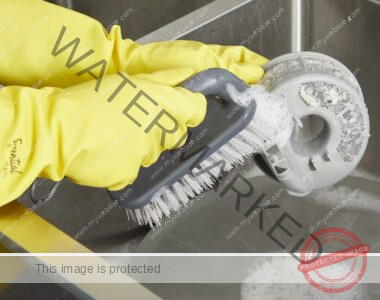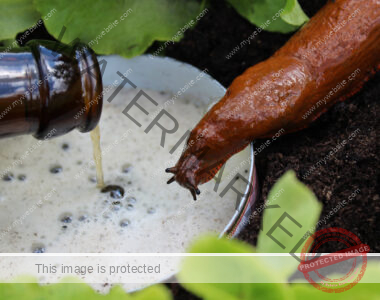
While colorful autumn leaves are gorgeous and freshly picked fruits variety of fruit trees While delicious, both can cause problems in your yard once they fall to the ground. So, while you often hear that Mulching fallen leaves While raking instead of raking in the fall is good for the soil and the ecosystem, take care to check debris before choosing that approach. According to fruit tree expert and founder Susan Poizner garden peopleLeaving fallen fruit and leaves in the yard and garden can cause disease and attract unwanted pests.
“Fallen leaves can be a good source of nutrients—but only if they’re healthy,” Poizner says. “If they’re diseased or infested with pests, you’re basically giving those pests and disease spores a comfortable place to overwinter,” she says. If not taken care of, these pathogens and pests will proliferate and return with a vengeance in the spring.
Learn how to spot fallen leaves caused by disease and pests, the best ways to dispose of them safely, and what steps to take to prevent this from happening again in the future.

Check fallen leaves and fruit for disease.
Poizner says it’s helpful to be familiar with the common disease problems that affect the types of trees on your property. “When you catch symptoms early, you can nip problems in the bud so they don’t spread.” common diseases These include fire blight, apple scab, rust, peach leaf curl, powdery mildew and bacterial canker.
When you’re examining fallen leaves, look for signs like spots or discoloration. “For example, orange-colored spots on leaves often mean rust, while olive-colored spots may be a sign of scab,” Poizner says. “Caught or distorted leaves can cause curling of peach leaves.”
Spots on leaves are a good indication that a tree has been infected. Almost all trees and shrubs are susceptible to one or more leaf spot diseases. Look for these clues:
- Spots, which may vary in size and color. Depending on the specific disease and its stage, brown, gray, black, yellow, yellow-green, orange and red spots may appear.
- Spots that appear round or angular, raised or sunken and with smooth or serrated edges.
- Concentric rings or dark ridges that grow larger over time and form spots. These are problematic.
- Premature falling of leaves, a sign of some diseases.

Keep an eye out for insects around fallen fruits and leaves.
Fallen leaves can fall easily attract a variety of insectsRodents, and other pests come to your yard because they provide a favorable shelter and nesting place. “Webbed or curled leaves may indicate pests,” Poizner says. She also explains how fallen fruit Can provide quick shelter to insects. “If you see fallen fruit that has holes in it and the pulp is leaking out, this could be a sign of insects inside.”
Some of the most common insects attracted to fallen leaves include:
- beetle: Decaying leaves provide a source of food and a comfortable place for beetles as they thrive in confined, dark, warm, humid and moist environments. Although beetles are generally good for the garden, you may not want them coming into your home if your leaves are near an entryway.
- Termite: These insects often use fallen leaves for shelter because they contain cellulose. As leaves begin to decay, they release an odor that attracts termites. Termites in your leaf pile can quickly spread to nearby wood, such as your home.
- Cockroaches: Since they crave warmth and moisture, cockroaches sometimes use fallen leaves for food and shelter during the cold months. However, they can easily enter your home.
- Spiders: Leaf piles attract arachnids looking for food, including black widow spiders, which are venomous predators that often seek out small insects found around leaves.
- Rodents: Beetles are a great source of protein for rodents such as rats and mice, so they often end up in leaf litter that already contains beetles. Also, rodents seek shelter when temperatures drop.
- snake: Just as rodents roam around in piles of leaves to eat beetles, similarly snakes follow rodents.
The problem is that these pests can’t survive outside in leaf piles, but eventually make their way into your home. That’s why it’s so important to address this problem immediately and not let a pile of leaves accumulate for weeks or months.
Safely dispose of diseased or infected organic material.
Prompt cleanup and disposal is necessary to prevent further spread of the disease. “If you’re not good at spotting and identifying disease symptoms, it’s better to play it safe and collect any organic matter around your fruit trees,” Poizner says. She suggests waiting for the leaves and fruits to fall to the ground naturally and then collecting everything together at municipal leaf waste collection. “If we collect fallen leaves and fruits over the winter, we can disrupt pest and disease life cycles and protect our trees without chemicals.” Place debris in sealed bags and covered trash cans.
Avoid planting diseased leaves And infected fruits in your home compost because those pathogens will hide there, Poisner advises. “You need a huge, hot compost pile to kill pathogens and pests, but home compost is rarely that hot.” In fact, composting infected plant matter is risky and challenging; The compost pile will need to be maintained at a temperature between 140 and 160 degrees Fahrenheit and turned frequently. Nevertheless, some viral diseases may still survive.
Burying leaves is another option. Some diseases can survive for years in the soil, so bury the debris as far away from the garden as possible in an area you don’t plan to use for garden plants. Dig a hole 1 to 2 feet deep, fill it with plant debris, mix soil, and then cover it with at least 2 inches of fresh disease-free soil. You can speed up the decomposition of leaves by raking them before burying them, but be sure to disinfect your tools after doing so to prevent spreading the disease to healthy trees and plants.
Avoid burning leavesA dangerous and illegal practice in many places. Even the slightest wind can carry burning materials and ignite destructive wildfires.

Prevent these problems from recurring next season.
To avoid future pests and diseases, take preventative measures, such as keeping your garden clean and treating vegetation. “Fall cleanup is a great start. pick up carefully-These leaves and fruits can harbor pests and diseases that can affect your tree again the next season,” Poizner says.
Additionally, she recommends Using Passive Spray In early spring before buds break. “I use a lemon-sulfur neutralizing oil mixture, which is effective but not the only option. The oil in this mixture gets onto the branches and bark (be sure to spray into cracks and crevices), killing any insects overwintering on your tree. This can prevent many pest problems during the growing season. Just remember to read the instructions carefully; Applying it at the wrong time or on the wrong tree can cause more harm than good.
She also suggests annual pruning To help protect trees from disease as it opens the tree for better air circulation and sunlight penetration. “This prevents the dark, moist conditions that pests and disease spores prefer,” Poizner says.



